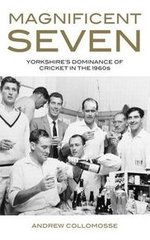Magnificent Seven
Martin Chandler |Published: 2010
Pages: 285
Author: Collomosse, Andrew
Publisher: Great Northern Books
Rating: 4 stars

Between 1890, when the official competition began, and 1968, there were 69 summers in which English cricket declared a Champion County. On no fewer than 29 occasions that accolade went to Yorkshire. In the 1930s and 1960s the White Rose was particularly dominant, and the 1968 title was their seventh in ten seasons. With just one further Championship to show for their efforts since 1968 the aura of near invincibility has gone, and there is therefore a generation of cricket lovers who have no memory of the days when a victory over Yorkshire was the cricketing equivalent of beating Manchester United at the theatre of dreams.
Andrew Collomosse’s book looks back at the swinging sixties and the great team that contained the likes of Brian Close, Ray Illingworth, Geoff Boycott and Fred Trueman. Those four were the biggest names, but by no means the only top class players – in 1966 a total of fourteen past, present or future internationals appeared for Yorkshire – all English of course – and all born within the county’s boundaries.
My main concern about this book was that it would amount to a sterile series of match reports accompanied by a few quotes from the players involved. I need not have worried. A book that, as a Lancastrian, I feared might be hard work, is not simply a history of Yorkshire County Cricket Club between 1959 and 1968. It is about the men who won those seven titles and it consists of their stories – there is not a scorecard in sight nor any sort of statistical appendix. On occasions such omissions are irritating and detract from the merits of a book, but they would have been out of place here.
Collomosse has interviewed fifteen surviving members of the Yorkshire teams of the period and has, for each of the eleven summers he covers (he includes 1969 as Yorkshire won the Gillette Cup that year), he provides a brief introduction, outlining the state of the nation, before one or two of the fifteen tell their life stories concentrating, of course, on the 1960s. Five more men who are no longer with us are briefly profiled as well. Illingworth and Close provide a foreword and an afterword respectively, and in doing so, as I suppose is only to be expected, contradict each other as to which of them was the driving force behind all the success. Only Boycott of the major players declined to get involved – I dare say there is a story behind that, but unfortunately that is one insight the reader does not gain.
The players recollections are set out in the first person but have been skilfully written – on many occasions different players mention the same match, and sloppy editing might have led to some tedious repetition, but that trap is avoided. The individual chapters, inevitably given the approach the book adopts, do not actually deal exclusively with the season whose date they bear, but there is a logic to the way the players are allocated to the individual years and while some will doubtless criticise it for me the formula worked, and I cannot think of a better way of setting the book out.
Through various books about them the thoughts and deeds of Close, Illingworth and Trueman are well known (although a reaction from Trueman to Close’s assertion that in 1948 and 1949 he was just as quick as Fiery Fred would have been interesting). Of the rest, men like Melvyn Ryan, Bob Platt and Bryan Stott tell their stories and express their opinions for the first time. For this reviewer one of the highlights is two of Trueman’s former opening partners, Ryan and Platt, talking about the great man.
When I realised what the format of the book was the contributions that appealed most were those of Richard Hutton and Geoff Cope. Hutton’s is a fascinating story – as the son of one of England’s finest ever batsmen and first professional captain, he came into the Yorkshire side as a fresh faced young amateur who had been playing for Cambridge University – not normally the sort of teammate received too warmly into the same dressing room as hard bitten professionals particularly when, as is constantly referred to, those men were not particularly well paid. Richard was a good enough all rounder to gain five England caps but left the game at 32. Of all the fifteen he is perhaps the one who most stays with the subject matter of the book and gives the least of himself. I hope one day that Richard Hutton’s life story will be published – perhaps it is a subject Andrew Collomosse might revisit?
Geoff Cope’s story is much more complete. Off spinner Cope has an excellent First Class record but his career was dogged by controversy about the legality of his bowling. Twice he remodelled his action and came back successfully, but despite the fact that he was never actually no-balled for throwing the doubters never left him alone and eventually, at 33, he left Yorkshire as, despite having every faith in his action, they felt unable to offer him anything other than a week to week contract. Fortunately Cope had a decent job to go to outside the game but his story is one from which cricket’s administrators, as well as the Yorkshire club, emerge with little credit.
Andrew Collomosse’s book is a gem, and not just for Yorkshiremen of a certain age. It is recommended reading for anyone who has an interest in County Cricket.







Leave a comment